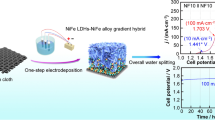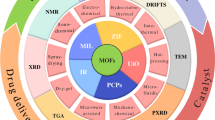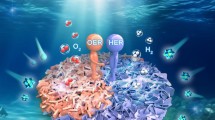Abstract
Iron-based catalysts are environmentally friendly, and iron minerals are abundant in the earth's crust, with great potential advantages for PMS-based advanced oxidation process applications. However, homogeneous Fe2+/PMS systems suffer from side reactions and are challenging to reuse. Therefore, develo** catalysts with improved stability and activity is a long-term goal for practical Fe-based catalyst applications. In this study, we prepared Fe-HNTs nanoreactors by encapsulating a nitrogen-doped carbon layer with one-dimensional halloysite nanotubes (HNTs) using the molten salt-assisted method. Subsequently, Fe (Co, Ni) nanoclusters were anchored onto the nitrogen-doped carbon layer at a relatively low temperature (550℃), resulting in stable and uniform distribution of metal nanoclusters on the surface of HNTs carriers in the form of Fe-Nx coordination. The results showed that the dissolution of the molten salt and leaching of post-treated metal oxides generated numerous mesopores within the Fe-HNTs nanoreactor, leading to a specific surface area more than 10 times that of HNTs. This enhanced mass transfer capability facilitates rapid pollutant removal while exposing more active sites. Remarkably, Fe-HNTs adsorbed up to 97% of tetracycline within 60 min. In the Fe-HNTs/PMS system, the predominant reactive oxygen species has been shown to be 1O2, and the added tetracycline was degraded by more than 98% within 5 min. The removal of tetracycline was maintained above 96% in the presence of interfering factors such as wide pH (3–11) and inorganic anions (5 mM Cl−, HCO3−, NO3−, and SO42−). The investigated mechanism suggests that efficient degradation and interference resistance of the Fe-HNTs/PMS system is attributed to the synergistic effect between the rapid adsorption of porous structure and the non-radical (1O2)-dominated degradation pathway.
Graphical Abstract












Similar content being viewed by others
Data availability
The datasets generated during and/or analyzed during the current study are available from the corresponding author on reasonable request.
Abbreviations
- M–N-C:
-
Metal-nitrogen-carbon
- HNTs:
-
Halloysite nanotubes
- Fe-HNTs:
-
Fe/N/C@HNTs
- Co-HNTs:
-
Co/N/C@HNTs
- Ni-HNTs:
-
Ni/N/C@HNTs
- TC:
-
Tetracycline
- NFA:
-
Norfloxacin
- RhB:
-
Rhodamine
- MB:
-
Methylene blue
- AOPs:
-
Advanced oxidation processes
- PMS:
-
Peroxymonosulfate
- TBA:
-
Tert-butanol
- SEM:
-
Scanning electron microscopy
- XRD:
-
X-ray diffraction
- TEM:
-
Transmission electron microscope
- EDS :
-
Energy dispersive spectroscopy
- XPS:
-
X-ray photoelectron spectroscopy
- BET:
-
Brunauer–Emmett–Teller
- FTIR :
-
Fourier transform infrared spectrometer
- EPR:
-
Electron paramagnetic resonance
- LC-MS:
-
Liquid chromatography-mass spectrometry
- ROS:
-
Reactive oxygen species
- COD :
-
Chemical oxygen demand
- FFA:
-
Furfuryl alcohol
- MeOH:
-
Methanol
References
Bai R, Yan W, **ao Y, Wang S, Tian X, Li J, **ao X, Lu X, Zhao F (2020) Acceleration of peroxymonosulfate decomposition by a magnetic MoS2/CuFe2O4 heterogeneous catalyst for rapid degradation of fluoxetine. Chem Eng J 397:125501
Buhani DJS, Fajriyah NS, Rilyanti M, Suharso S, Elwakeel KZ (2023a) Modification of non-activated carbon from rubber fruit shells with 3-(aminopropyl)-triethoxysilane and its adsorption study on coomassie brilliant blue and methylene blue in solution. Water Air Soil Pollut 234:578
Buhani B, Suharso S, Rilyanti M, Antika FDR, Lestari LP, Sumadi S, Ansori M, Elwakeel KZ (2023b) Functionalization of carbon from rubber fruit shells (Hevea brasiliensis) with silane agents and its application to the adsorption of bi-component mixtures of methylene blue and crystal violet. Environ Sci Pollut Res
Buxton GV, Greenstock CL, Helman WP, Ross AB (1988) Critical review of rate constants for reactions of hydrated electrons, hydrogen atoms and hydroxyl radicals (.OH/.O-) in aqueous solution. J Phys Chem Ref Data 17:513–886
Cao J, Yang Z, **ong W, Zhou Y, Wu Y, Jia M, Sun S, Zhou C, Zhang Y, Zhong R (2020) Peroxymonosulfate activation of magnetic Co nanoparticles relative to an N-doped porous carbon under confinement: boosting stability and performance. Sep Purif Technol 250:117237
Chen F, Liu LL, Wu JH, Rui XH, Chen JJ, Yu Y (2022) Single-atom iron anchored tubular g-C3N4 catalysts for ultrafast fenton-like reaction: roles of high-valency iron-oxo species and organic radicals. Adv Mater 34:02891
Cheng G, Hao H, **e S, Wang X, Dai M, Huang L, Yuan Z (2014) Antibiotic alternatives: the substitution of antibiotics in animal husbandry? Front Microbiol 5:217
Cheng M, Zeng G, Huang D, Lai C, Xu P, Zhang C, Liu Y (2016) Hydroxyl radicals based advanced oxidation processes (AOPs) for remediation of soils contaminated with organic compounds: a review. Chem Eng J (Lausanne, Switzerland: 1996) 284:582–598
Cuerda-Correa EM, Alexandre-Franco MF, Fernández-González C (2020) Advanced oxidation processes for the removal of antibiotics from water. An overview. Water (basel) 12:102
Babu DS, Srivastava V, Nidheesh PV, Kumar MS (2019) Detoxification of water and wastewater by advanced oxidation processes. Sci Total Environ 696:133961
Dominguez CM, Rodriguez V, Montero E, Romero A, Santos A (2020) Abatement of dichloromethane using persulfate activated by alkali: a kinetic study. Sep Purif Technol 241:116679
Gao Y, Zhu Y, Li T, Chen Z, Jiang Q, Zhao Z, Liang X, Hu C (2021) Unraveling the high-activity origin of single-atom iron catalysts for organic pollutant oxidation via peroxymonosulfate activation. Environ Sci Technol 55:8318–8328
Gu D, Guo C, Hou S, Lv J, Zhang Y, Feng Q, Zhang Y, Xu J (2019) Kinetic and mechanistic investigation on the decomposition of ketamine by UV-254 nm activated persulfate. Chem Eng J 370:19–26
Gu A, Chen K, Zhou X, Gong C, Wang P, Jiao Y, Mao P, Chen K, Lu J, Yang Y (2023) Trimetallic MOFs-derived Fe-Co-Cu oxycarbide toward peroxymonosulfate activation for efficient trichlorophenol degradation via high-valent metal-oxo species. Chem Eng J (Lausanne, Switzerland: 1996) 468:143444
He J, Wan Y, Zhou W (2021) ZIF-8 derived Fe-N coordination moieties anchored carbon nanocubes for efficient peroxymonosulfate activation via non-radical pathways: Role of FeNx sites. J Hazard Mater 405:124199
Huang H, Guo T, Wang K, Li Y, Zhang G (2021) Efficient activation of persulfate by a magnetic recyclable rape straw biochar catalyst for the degradation of tetracycline hydrochloride in water. Sci Total Environ 758:143957
Iakovides IC, Michael-Kordatou I, Moreira NFF, Ribeiro AR, Fernandes T, Pereira MFR, Nunes OC, Manaia CM, Silva AMT, Fatta-Kassinos D (2019) Continuous ozonation of urban wastewater: removal of antibiotics, antibiotic-resistant Escherichia coli and antibiotic resistance genes and phytotoxicity. Water Res 159:333–347
Ji Y, **e W, Fan Y, Shi Y, Kong D, Lu J (2016) Degradation of trimethoprim by thermo-activated persulfate oxidation: reaction kinetics and transformation mechanisms. Chem Eng J 286:16–24
Karkman A, Parnanen K, Larsson DGJ (2019) Fecal pollution can explain antibiotic resistance gene abundances in anthropogenically impacted environments. Nat Commun 10:80
Khan ZA, Elwakeel KZ, Mashabi RA, Elgarahy AM (2024) Adsorption of anionic dyes onto 1,5-diphenylcarbazide functionalized magnetic hybrid polymer: impact of water salinity and surfactants on adsorption isotherms. J Ind Eng Chem (Seoul, Korea) 131:569–584
Kifle GA, Huang Y, **ang M, Wang W, Wang C, Li C, Li H (2022) Heterogeneous activation of peroxygens by iron-based bimetallic nanostructures for the efficient remediation of contaminated water. A review. Chem Eng J 442:136187
Kim K-R, Owens G, Kwon S-I, So K-H, Lee D-B, Ok YS (2012) Occurrence and environmental fate of veterinary antibiotics in the terrestrial environment (vol 214, pg 163, 2011). Water Air Soil Pollut 223:6213–6214
Lee J, von Gunten U, Kim J-H (2020) Persulfate-based advanced oxidation: critical assessment of opportunities and roadblocks. Environ Sci Technol 54:3064–3081
Li Z, Guo C, Lyu J, Hu Z, Ge M (2019) Tetracycline degradation by persulfate activated with magnetic Cu/CuFe2O4 composite: efficiency, stability, mechanism and degradation pathway. J Hazard Mater 373:85–96
Li R, Tang X, Wu J, Zhang K, Zhang Q, Wang J, Zheng J, Zheng S, Fan J, Zhang W, Li X, Cai S (2023) A sulfonate-functionalized covalent organic framework for record-high adsorption and effective separation of organic dyes. Chem Eng J (Lausanne, Switzerland: 1996) 464:142706
Ma C, Guo Y, Zhang D, Wang Y, Li N, Ma D, Ji Q, Xu Z (2023) Metal-nitrogen-carbon catalysts for peroxymonosulfate activation to degrade aquatic organic contaminants: rational design, size-effect description, applications and mechanisms. Chem Eng J (Lausanne, Switzerland: 1996) 454:140216
Matzek LW, Carter KE (2016) Activated persulfate for organic chemical degradation: a review. Chemosphere (oxford) 151:178–188
Niu L, Zhang G, **an G, Ren Z, Wei T, Li Q, Zhang Y, Zou Z (2021) Tetracycline degradation by persulfate activated with magnetic gamma-Fe2O3/CeO2 catalyst: performance, activation mechanism and degradation pathway. Sep Purif Technol 259:118156
Peng L, Shang Y, Gao B, Xu X (2021) Co3O4 anchored in N, S heteroatom co-doped porous carbons for degradation of organic contaminant: role of pyridinic N-Co binding and high tolerance of chloride. Appl Catal B 282:119484
Rizzo L, Manaia C, Merlin C, Schwartz T, Dagot C, Ploy MC, Michael I, Fatta-Kassinos D (2013) Urban wastewater treatment plants as hotspots for antibiotic resistant bacteria and genes spread into the environment: a review. Sci Total Environ 447:345–360
Rodriguez-Mozaz S, Chamorro S, Marti E, Huerta B, Gros M, Sanchez-Melsio A, Borrego CM, Barcelo D, Luis Balcazar J (2015) Occurrence of antibiotics and antibiotic resistance genes in hospital and urban wastewaters and their impact on the receiving river. Water Res 69:234–242
Rossiter SE, Fletcher MH, Wuest WM (2017) Natural Products as platforms to overcome antibiotic resistance. Chem Rev 117:12415–12474
Sun Q, Ke M, Zhao Y, Wang B, Zhang J, Sheng J (2021a) Embellishing 001 surface of Bi2MoO6 nanobelts with enhanced photocatalytic performance and mechanisms exploration. Appl Surf Sci 563:150104
Sun Q, Zhao Y, Qin F, Zhang J, Wang B, Ye H, Sheng J (2021b) Crystallinity and photocatalytic properties of BiVO4/halloysite nanotubes hybrid catalysts for sunlight-driven decomposition of dyes from aqueous solution. Nanotechnology 32:135602
Urra J, Alkorta I, Mijangos I, Epelde L, Garbisu C (2019) Application of sewage sludge to agricultural soil increases the abundance of antibiotic resistance genes without altering the composition of prokaryotic communities. Sci Total Environ 647:1410–1420
Wang J, Wang S (2021) Effect of inorganic anions on the performance of advanced oxidation processes for degradation of organic contaminants. Chem Eng J 411:128392
Wang J, Zhi D, Zhou H, He X, Zhang D (2018) Evaluating tetracycline degradation pathway and intermediate toxicity during the electrochemical oxidation over a Ti/Ti4O7 anode. Water Res 137:324–334
Wang M, Wang Q, Cai Y, Yuan R, Wang F, Qian Y, Chen Z, Zhou B, Chen H (2021) Efficient degradation and defluorination of perfluorobutyric acid under UV irradiation in the presence of persulfate. J Clean Prod 327:129472
Wei Y, Liu R, Liu H, Sun Y, Liu G, Wang Z, Luo Y, Tang X, Zhang X, Hu J (2021) Controllable one-dimensional growth of metal-organic frameworks based on uncarved halloysite nanotubes as high-efficiency solar-fenton catalysts. J Phys Chem C 125:25565–25579
**e Z-H, He C-S, Pei D-N, Dong Y, Yang S-R, **ong Z, Zhou P, Pan Z-C, Yao G, Lai B (2023a) Review of characteristics, generation pathways and detection methods of singlet oxygen generated in advanced oxidation processes (AOPs). Chem Eng J 468:143778
**e Z-H, He C-S, Pei D-N, Dong Y, Yang S-R, **ong Z, Zhou P, Pan Z-C, Yao G, Lai B (2023) Review of characteristics, generation pathways and detection methods of singlet oxygen generated in advanced oxidation processes (AOPs). Chem Eng J (Lausanne, Switzerland: 1996) 468:143778
**n S, Liu G, Ma X, Gong J, Ma B, Yan Q, Chen Q, Ma D, Zhang G, Gao M, **n Y (2021) High efficiency heterogeneous Fenton-like catalyst biochar modified CuFeO2 for the degradation of tetracycline: economical synthesis, catalytic performance and mechanism. Appl Catal B 280:119386
Xu Z, Song X, Li Y, Li G, Luo W (2019) Removal of antibiotics by sequencing-batch membrane bioreactor for swine wastewater treatment. Sci Total Environ 684:23–30
Yang Z, Qian J, Yu A, Pan B (2019) Singlet oxygen mediated iron-based Fenton-like catalysis under nanoconfinement. Proc Natl Acad Sci USA 116:6659–6664
Zhang Y, Li Y, Bi H, Zhou S, Chen J, Zhang S, Huang Y, Chang F, Zhang H, Wagberg T, Hu G (2023) Nanomanganese cobaltate-decorated halloysite nanotubes for the complete degradation of ornidazole via peroxymonosulfate activation. J Colloid Interface Sci 630:855–866
Zhu Z, Huo P, Lu Z, Yan Y, Liu Z, Shi W, Li C, Dong H (2018) Fabrication of magnetically recoverable photocatalysts using g-C3N4 for effective separation of charge carriers through like-Z-scheme mechanism with Fe3O4 mediator. Chem Eng J 331:615–625
Funding
The authors acknowledge the financial support provided by the Engineering Research Center of Non-metallic Minerals of Zhejiang Province (ZD2023K04), China Postdoctoral Science Foundation (2022M723394), and Zhejiang Provincial Natural Science Foundation of China (LY24E040002).
Author information
Authors and Affiliations
Contributions
Qing Sun: conceptualization, methodology, data curation, and funding acquisition. Jiale Yu: methodology, writing, and visualization. Youpu Zhao: formal analysis, data curation, visualization, and writing. Hanhu Liu: review and editing and investigation. Chunsheng Li: supervision and resources. Jiajun Tao: visualization and data curation. Jian Zhang: supervision and investigation. Jiawei Sheng: project administration and funding acquisition.
Corresponding author
Ethics declarations
Ethics approval
This article does not contain any studies with human participants or animals performed by any of the authors.
Consent to participate
All authors have given their consent to participate in submitting this manuscript to this journal.
Consent for publication
All authors have given their consent to publish this paper in this journal.
Competing interests
The authors declare no competing interests.
Additional information
Responsible Editor: George Z. Kyzas
Publisher's Note
Springer Nature remains neutral with regard to jurisdictional claims in published maps and institutional affiliations.
Supplementary Information
Below is the link to the electronic supplementary material.
Rights and permissions
Springer Nature or its licensor (e.g. a society or other partner) holds exclusive rights to this article under a publishing agreement with the author(s) or other rightsholder(s); author self-archiving of the accepted manuscript version of this article is solely governed by the terms of such publishing agreement and applicable law.
About this article
Cite this article
Sun, Q., Yu, J., Zhao, Y. et al. Subnano-Fe (Co, Ni) clusters anchored on halloysite nanotubes: an efficient Fenton-like catalyst for the degradation of tetracycline. Environ Sci Pollut Res 31, 28210–28224 (2024). https://doi.org/10.1007/s11356-024-32947-1
Received:
Accepted:
Published:
Issue Date:
DOI: https://doi.org/10.1007/s11356-024-32947-1




